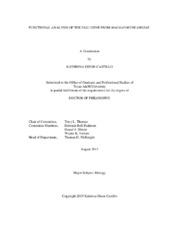| dc.description.abstract | Magnaporthe oryzae is the causative agent of blast disease, which destroys economically important crops such as rice, wheat and barley. Successful infection relies on the ability of the fungus to sense both environmental and host surface signals at different stages of the disease cycle. Surface sensing is carried out in part by G protein-coupled receptors. This project is focused on the functional analysis of PLG1, a member of the M. oryzae PTH11 class of GPCR-like proteins.
Targeted deletion of PLG1 generated a mutant that is unable to infect intact rice and barley plants, but is capable of invasive growth on wounded leaves. M. oryzae requires a hard and hydrophobic surface to develop necessary infection structures. Infection-related morphogenesis assays on a hydrophobic membrane showed that germ tube hooking and apical swelling occurred in the Δplg1 mutant, but appressoria formed at only 10% of the wild type frequency. To assess its signaling role, cAMP and diacylglycerol (DAG) were exogenously added to the developing Δplg1 spores. On a hydrophobic surface, addition of cAMP alone, DAG alone, and both cAMP and DAG resulted in appressorium formation frequencies of 55%, 39% and 58%, respectively. When similar treatments were done for the Δplg1 mutant on a hydrophilic surface, almost no appressoria were observed upon addition of either cAMP or DAG, but appressoria formed up to 17% when both inducers were present. Moreover, evident disease symptoms on barley were observed upon DAG-treatment of the Δplg1 mutant. Also, the transcript level of PKC, a gene that is downstream of the DAG-related pathway was found to be significantly reduced in the Δplg1 mutant at 24 hours post exposure on Teflon. Taken together, these data suggest a potential role for PLG1 as a major activator of the signaling pathways related to DAG. The last 46 amino acids in the cytoplasmic region of PLG1 weakly interacts with the Gα subunit MagB in a yeast two hybrid assay, strengthening the possibility that PLG1 could be a M. oryzae GPCR.
Overall, this body of work contributed to a better understanding of M. oryzae appressorium development by defining a good GPCR candidate for transducing signals via the DAG-mediated pathway. | en |


